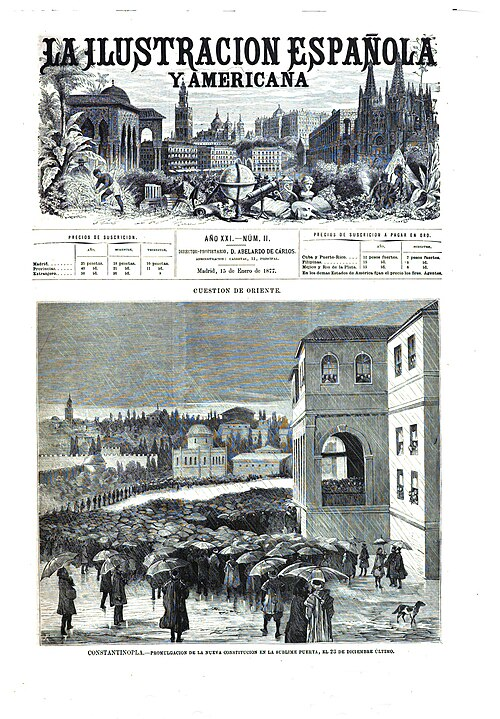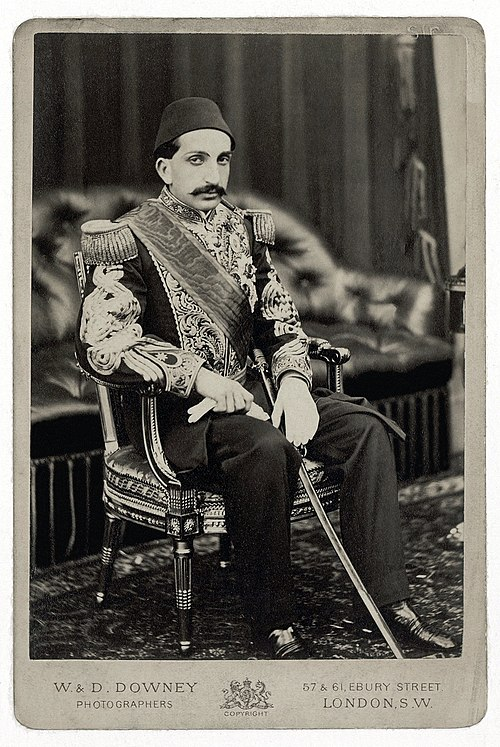IB Syllabus focus:
'Examine the causes, aims, and effects of Tanzimat reforms and the rule of Abdul Hamid, including reactions and reform efforts.'
In the 19th century, the once-mighty Ottoman Empire was confronted with a host of challenges that necessitated extensive reforms. These reforms, collectively known as the Tanzimat, were implemented over a period of several decades, seeking to thoroughly modernise the empire’s structures and systems in the face of external threats and internal weaknesses.
Causes of Reforms
External Pressures
European Military Superiority: Defeats such as those in the Russo-Turkish wars exposed the military weaknesses of the Ottoman Empire.
Economic Challenges: The capitulations and trade imbalances in favour of European powers revealed the need for economic reform.
Internal Pressures
Administrative Inefficiency: The cumbersome and outdated provincial administration system was unable to effectively govern the diverse and sprawling empire.
Rise of Nationalism: Emerging nationalist movements within the empire's domains presented a significant threat to the unity of the state.
Aims of Tanzimat Reforms
Centralisation and Modernisation of State Structures
Strengthening the Central Government: Reforms were directed at reducing the power of local feudal lords and bringing more direct control under the Sultan’s government.
Establishment of a Contemporary Bureaucracy: A modern civil service was envisioned to replace the old system of patronage and corruption.
Legal and Educational Overhauls
Uniform Legal Framework: The goal was to create a unified legal system that was not based on religious laws but rather on secular, codified laws.
Creation of a Secular Education System: To diminish the influence of religious schools and to cultivate a secular, loyal bureaucratic and military class.
Economic and Military Rejuvenation
Developing Infrastructure: Building railways, telegraph lines, and modern roads was essential for economic integration and military logistics.
Reforming the Military: The obsolete military structure needed revamping, including modern training, conscription, and weaponry.
Tanzimat Reforms (1839–1876)
Foundational Edicts and Legislation
Hatt-i Sharif of Gülhane (1839): This edict promised rights such as security of life, honour, and property, seeking to create a new relationship between the state and its subjects.
Hatt-i Humayun (1856): Reinforced the earlier reforms and mandated equality regardless of religion or ethnicity, aiming to unify the empire under a common legal framework.
Legal Reforms
Code of Commerce and Code of Maritime Laws: Modelled after French laws, these sought to standardise commercial activities and dispute resolutions.
Penal Reform: A new penal code was introduced, inspired by European legal systems, which reduced the traditional role of religious courts.
Social Reforms
Emancipation of Non-Muslims: Non-Muslim subjects were granted various civil liberties, such as the right to own property and equal treatment before the law.
Public Works and Infrastructure: Significant investment was made in public works, such as the construction of the Istanbul-Baghdad Railway, which was meant to integrate the economy and bolster defence capabilities.
Abdul Hamid II and Reactionary Rule (1876–1909)
Early Constitutional Period
Adoption of the Constitution: In 1876, under pressure, Abdul Hamid II conceded to the implementation of a constitution and a representative parliament.

An 1877 engraving depicts the public promulgation of the Ottoman Constitution (Kanûn-ı Esâsî) in Istanbul, capturing the ceremonial and political significance of the First Constitutional Era. The scene helps illustrate how constitutionalism emerged from reformist pressures within the state during the Tanzimat legacy. Source
Centralisation and Censorship
Suspension of the Constitution: Within two years, the Sultan suspended the new constitution and reverted to autocratic rule, centralising power and instituting censorship.

Formal portrait of Abdul Hamid II (c. 1867), whose long reign (1876–1909) combined selective modernization with autocratic centralization and a pronounced emphasis on Islamic legitimacy. Use this image to anchor discussion of censorship, intelligence networks, and the limits of Tanzimat constitutionalism under his rule. Source
Intelligence Network: He developed an extensive network of spies and informers to quell dissent and maintain control over the population.
Educational and Cultural Policies
Islamic Education: Abdul Hamid emphasised traditional Islamic education to counteract the secularising influences of the Tanzimat.
Cultural Paternalism: The Sultan positioned himself as the Caliph, a spiritual leader for Muslims, to garner support and loyalty across the empire.
Economic Projects
Hejaz Railway: One of Abdul Hamid’s most notable infrastructure projects, intended to facilitate pilgrimage to Mecca and strengthen ties with Arab provinces.
Effects of Tanzimat Reforms and Abdul Hamid's Rule
Political and Administrative Outcomes
Modernised Administration: The empire’s administrative apparatus became more efficient but was met with resistance from those who favoured traditional governance.
Increased Centralisation: The centralisation of power often alienated regional leaders and fostered resentment.
Social and Economic Impact
Urbanisation and Public Services: Reforms led to increased urbanisation, and some improvement in public services was evident, although benefits were not universally felt.
Economic Dependency: Despite attempts at economic modernisation, the empire increasingly relied on European loans and investments, leading to significant debt.
Cultural Shifts
Secular versus Religious Education: The Tanzimat’s secular reforms in education created a rift with the traditional Islamic scholarship, which was somewhat reversed under Abdul Hamid II.
Ethnic and Religious Identity: Attempts to create a unified Ottoman identity were often at odds with the rising tide of ethnic nationalism and religious conservatism.
Reactions and Further Reform Efforts
The Young Ottomans and Liberal Opposition
Ideology of Constitutionalism: The Young Ottomans, a movement among intellectuals and civil servants, pushed for a return to constitutional governance and further modernisation.
Response to Nationalism
Autonomy Movements: As centralisation efforts intensified, so did the desire for autonomy or independence among various ethnic and religious groups within the empire.
Arab Revolt: This was particularly pronounced in the Arab provinces, where calls for Arab nationalism began to resonate strongly towards the end of Abdul Hamid II’s rule.
Impact on Subsequent Reforms
Foundation for Future Reforms: Although not all Tanzimat reforms were successful or popular, they laid the groundwork for future modernisation efforts, including those of the Young Turks and Mustafa Kemal Atatürk.
These reforms marked a period of significant transition for the Ottoman Empire, demonstrating the complexities of modernising a vast, multi-ethnic empire. They reflect the interplay between the traditional structures of the empire and the inexorable pull of modernising influences from Europe, which would eventually culminate in the radical transformations of the early 20th century.
FAQ
The Tanzimat reforms aimed to revitalise the Ottoman economy through modernisation and by creating a more favourable environment for trade and investment. Measures included the modernisation of the tax system, attempts to standardise and regulate agricultural production, and efforts to develop local industries to reduce dependency on European imports. However, these reforms were only partially successful. The capitulations, agreements that granted privileges to European merchants, continued to undermine the empire's economic sovereignty. Moreover, the financial reforms could not fully counteract the trade imbalances or stop the increase in foreign debt, which led to significant European financial control by the end of the 19th century.
The Tanzimat era saw substantial military reforms, which included the establishment of a modern conscription system aimed at creating a reliable and disciplined standing army. Efforts were made to modernise training and military education, with the establishment of military academies and the adoption of European military techniques and organisation. The reforms also sought to update the empire's arsenal by investing in new weaponry and technology. Despite these efforts, the military's effectiveness was hampered by logistical challenges, insufficient funding, and resistance from traditional factions within the military establishment that were opposed to the new order.
The introduction of the Ottoman Civil Code, or Mecelle, between 1869 and 1876, was a groundbreaking attempt to codify Islamic law in terms of modern legal concepts, reflecting the Tanzimat reformers’ aim to harmonise traditional laws with the needs of a modern state. It signified a move away from the case-by-case fatwas of Islamic jurisprudence to a systematised set of laws that could be applied uniformly across the empire. The Mecelle played a significant role in the secularisation of law, reducing the role of religious courts and bringing the legal system closer to European models, thereby facilitating trade and interaction with Europe while aiming to protect the rights and properties of Ottoman citizens.
Reactions among the Ottoman elite to the Tanzimat reforms were varied and had a profound impact on the political landscape. Many in the bureaucratic and ruling classes saw the reforms as necessary for the survival and modernisation of the state. However, some conservative elements within these groups viewed them as a threat to the social order and the traditional balance of power. This divide led to political friction and instability, which sometimes resulted in reactionary policies, such as those of Sultan Abdul Hamid II, who curtailed the reforms in favour of a more autocratic and traditionalist approach. The polarised responses also paved the way for the emergence of more radical movements, including the Young Turks, who later sought to restore and extend the reformist agenda.
Ottomanism was a concept that aimed to foster a sense of common citizenship and loyalty to the empire among its diverse populace, irrespective of ethnic or religious identity. This ideology underpinned many Tanzimat reforms, particularly those focused on legal and administrative equality. However, its reception was mixed. While some segments, especially within the Ottoman elite, embraced the idea, it was less successful with ethnic minorities. Many of these groups, such as Armenians, Arabs, and Balkan Christians, were already developing national consciousnesses that clashed with the pan-Ottoman identity. This discrepancy between the reformers’ intentions and the minorities’ aspirations often resulted in increased tension and, in some instances, contributed to the rise of nationalist movements seeking greater autonomy or independence.
Practice Questions
The Tanzimat reforms fundamentally transformed the Ottoman administrative structure by introducing a degree of centralisation previously unseen. The establishment of a more systematic and bureaucratised government replaced the arbitrary feudal systems, thus promoting the efficiency and unity of the Empire. However, these reforms often met resistance from local powers who were disinclined to surrender their autonomy. Despite the opposition, the Tanzimat period was crucial in laying the foundation for a modern state apparatus, although it inadvertently intensified nationalistic sentiments among various ethnic groups, leading to further internal conflicts.
Abdul Hamid II's rule was marked by a conspicuous departure from the Tanzimat’s vision of a modern, constitutional state. While the Tanzimat aimed at establishing a legal and administrative framework conducive to liberal reform, Abdul Hamid II reinstated autocratic governance, heavily relying on Islamic legitimacy and censorship. His policies were a reaction to the perceived failure of the Tanzimat to stabilise the Empire, particularly its liberal aspects which had alienated conservative factions. Nevertheless, Abdul Hamid did continue with some modernisation efforts, such as infrastructure development, suggesting a complex relationship with Tanzimat objectives rather than a wholesale contradiction.

